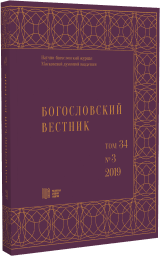Chalcedon Cathedral, Its Reception and Some Aspects of Christology in V — Early VI Century
DOI:
https://doi.org/10.31802/2500-1450-2019-34-67-88Keywords:
The Council of Chalcedon, the chalcedoniens, hypostasis, person, nature, Christ, God the Word, Leo the Great, Gennadius of Constantinople, the monk Nephalius, John the Grammarian of CaesareaAbstract
This article provides a brief overview of the theological, historical and cultural perception of the Chalcedonian Councel in the Christian East in the second half of the V — and the early VI centuries. Its results prompted many theologians to attempt to defend or refute Chalcedon. The reason for this is the teaching of the Council about the presence of two natures in Christ after the incarnation and their unity «in one person or hypostasis of Christ». From the followers of Chalcedon Counsel, such as St. Leo the Great, Gennady of Constantinople, monk Nephalius, John of Caesarea was a number of attempts to explain the doctrine of the two natures and single hypostasis or person. The Christological of synthesis Chalcedon and St. Cyril of Alex- andria in the largest degree was presented by the Grammarian in the formula «in the person of God of the Word» to connect the two natures and the theopaschite formula «Unus de Trinitate passus est carne» (заменил на латинское), which can be called the first steps to the formulation of the doctrine of the inclusion of flesh in the hypostasis of God of the Word.
Downloads
References
Источники
Ad Petrum Antiochenum. Epistulae // ACO. Т. 3 / еd. E. Schwartz. Berlin: W. de Gruyter, 1940. S. 6–25.
Cyrillus Alexandrinus. Ad Augustas de fide // ACO. Т. 1. Vol. 1. Pars 5 / еd. E. Schwartz. Berlin: W. de Gruyter, 1938. S. 26–61.
Cyrillus Alexandrinus. Ad Succensum. Epistulae 1–2 // ACO. Т. 1. Vol. 1. Pars 6 / ed. E. Schwartz. Berlin: W. de Gruyter, 1938. S. 151–162.
Joannes Damascenus. Expositio fidei orthodoxae 47 // PG. 94. Col. 989A.
Synodus Chalcedonensis. Actio IV. Definitio fidei // ACO. T. 2. Vol. 1. Pars 2. P. 129.
Cyrillus Alexandrinus. Apologia // ACO. Т. 1. Vol. I. Pars 6 / ed. E. Schwartz. Berlin: W. de Gruyter, 1938. S. 107–146.
Cyrillus Alexandrinus. Contra Nestorium // ACO. T. 1. Vol. 1. Pars 6 / еd. E. Schwartz. Berlin: W. de Gruyter, 1937. S. 13–106.
Cyrillus Alexandrinus. Epistula altera ad Nestorium // ACO. T. 1. Vol. 1. Pars 1 / еd. E. Schwartz. Berlin: W. de Gruyter, 1937. S. 25–28.
Synodus Chalcedonensis. Actio III. Epistulae Cyrilli et Tonus Leonis // ACO. T. 2. Vol. 1. Pars 2 / еd. E. Schwartz. Berlin: W. de Gruyter, 1933. S. 67–84.
Synodus Chalcedonensis. Actio IV. Definitio fidei // ACO. Т. 2. Vol. 1. Pars 2 / еd. E. Schwartz. Berlin: W. de Gruyter, 1933. S. 129–130.
Diekamp F. Analecta patristica. Texte und Abhandlungen zur griechischen Patristik. Roma: Pontificium Institutus Orientalis, 1938. (Orientalia christiana analecta; vol. 117).
Epistolae Cyrilli et Tomus Leonis // ACO. Т. 2. Vol. 1. Pars 2 / еd. E. Schwartz. Berlin: W. de Gruyter, 1933. S. 67–84.
Joannes Damascenus. Expositio fidei orthodoxae // PG. Т. 94. Col. 790–1227.
Iohannis Caesariensis presbyteri et grammatici Opera quae supersunt / ed. M. Richard, M. Aubineau. Turnhout: Brepols; Leuven: University Press, 1977. (CCSG; vol. 1).
Grégoire de Nazianze. Lettres théologique / éd. et trad. par P. Gallay. Paris: Cerf, 1974. (SC; vol. 208).
Jean Rufus, évêque de Maiouma. Plérophories, c’est-à-dire témoignages et révélations contre le concile de Chalcédoine / version syriac et traduction français par F. Nau. Paris: Firmin- Didot, 1911. (PO; vol. 8/1). P. 1–208.
Leo Magnus. Tomus Leonis // ACO. Т. 2. Vol. 2. Pars 1 / еd. E. Schwartz. Berlin: W. de Gruyter, 1937. S. 24–33.
Leo Magnus. Ad Leonem Augustum (Epistula 104) // ACO. Т. 2. Vol. 4 / еd. E. Schwartz. Berlin: W. de Gruyter, 1937. S. 113–119.
Severi Antiocheni Liber contra impium Grammaticum. Oratio prima et secunda / еd., interpr.
Lebon. Louvain: Secrétariat du CSCO, 1933. (CSCO; vol. 111–112. Scriptori Syri; t. 58–59).
Severi Antiocheni Oratio ad Nephalium, Eiusdem ac Sergii Grammatici: Epistulae mutuae / éd. et trad. par J. Lebon. Louvain: Secrétariat du CSCO, 1949. (CSCO; vol. 119–120. Scriptori Syri; t. 64–65).
Zacharie le Scholastique. Vie de Sévère / textes syriaques publés, traduits et annotés par M.-A. Kugener. Turnhout: Brepols, 1993. (PO; vol. 2/1).
Евагрий Схоластик. Церковная история / пер. с греч., вступ. статья, коммент. и прил. И. В. Кривушина. СПб.: Издательство Олега Абышко, 2010.
Литература
Болотов В. В. Лекции по истории древней Церкви. Т. 4. СПб.: Спасо-Преображенский Валаамский Ставропигиальный монастырь, 1994.
Давыденков О., прот. Из истории сирийского монофизитства. Исторические предпосылки распространения монофизитства в Сирии // Богословский сборник. 1999. №. 3. С. 24–41. № 4. С. 20–29.
Карташев А. В. Вселенские Соборы. М.: Республика, 1994.
Мейендорф И., протопр. Иисус Христос в восточном православном богословии / пер. с англ. свящ. Олега Давыденкова. М.: ПСТГУ, 2000.
Dell’Osso C. L’inno Trisagion: origini e dispute teologiche. Motivi e forme della poesia cristiana antica tra Scrittura e traditione classica. Roma: Institutum Patristicum Augustinianum, 2008. (Studia ephimeridis «Augustinianum»; vol. 108).
Dell’Osso C. Cristo e Logos, il calcedonismo del VI secolo in Oriente. Roma: Institutum Patristicum Augustinianum, 2010. (Studia ephimeridis «Augustinianum»; vol. 118).
Gray P. T. R. The Difense of Chalcedon in the East (451–553). Leiden: Brill, 1979.
Grillemeier A., Heinthaler Th. Christ in Christian Tradition. Vol. 2/2. From the Council of Chalcedon (451) to Gregory the Great (590–604). The Church of Constantinople in the Sixth Century. London: Mowbray, Westminster John Knox Press, 1995.
Helmer S. Der Neochalkedonismus. Geschichte, Berechtigung und Bedeutung eines dogmengeschichtlichen Begriffe. Bonn: Rheinische Friedrich-Wilhelm-Universität, 1962.
Klein W. Der Autor der Joannis Orthodoxi Disputatio // Oriens Christianus. 1990. Bd. 74. S. 234–244.
Lebon J. Le Monophysisme sévérien. Étude historique, lettéraire et théologique sur la resistance monophysite au concile de Chalcédoine jusqu’à la costitution de l’Église Jacobite. Louvain: Van Linthout, 1909.
Moeller Chr. Un représentant de la christologie néo-chalcédonienne au début du VIe s. en Orient, Naphalius d’Alexandrie // Revue d’histoire ecclésiastique. 1944–1945. Vol. 40. P. 73–140.
Moeller Chr. Le chalcedonisme et le neo-chalcedonisme en Orient de 451 à la fin de VIe siècle // Das Konzil von Chalkedon. Вd. 1. Würzburg: Echter-Verlag, 1951. S. 637–720.
Moeller Chr. Un fragment du Type de l’empereur Anastase I // Studia patristica. 1961. Vol. 3. P. 240–245.
Patrologia. Vol. 5. Dal Concilio di Calcedonia (451) a Giovanni Damasceno (750). I Padri orientali / а cura di A. di Berrardino. Genova: Marietti, 2000.
Steppa J.-E. John Rufus and the World Vision of Anti-Chalcedonian Culture. New-Jersey: Gorgias Press, 2002.








